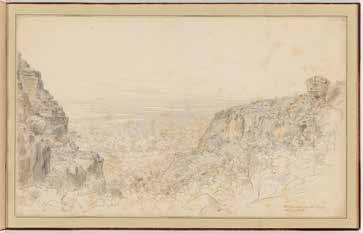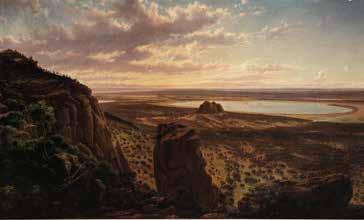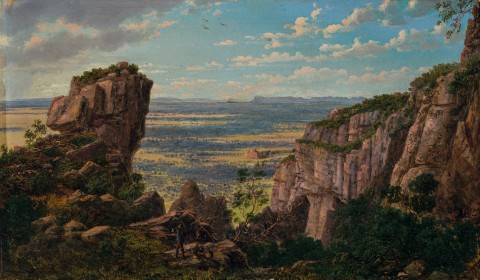MOUNT ARAPILES TOWARDS THE GRAMPIANS, 1870
EUGENE VON GUÉRARD
oil on academy board
18.5 x 30.5 cm
signed with initials and dated lower right edge: E. V. G. / 29.1.70.
bears inscription on frame verso: Left Hand side of Arapiles / … / A VIEW FROM MOUNT ARAPILES / WIMMERA DISTRICT / VICTORIA AUSTRALIA / ? 1868
Hon. J. A. Macpherson, Victoria
Thence by descent to the present owner, United Kingdom
[View from Arapiles and plant studies], 1868, pencil on paper, folio 36, Sketchbook XXXVI, in the collection of State Library of New South Wales, Sydney
The Mitre Rock and Lake from Mount Arapiles, 1874, oil on canvas, 61.2 x 106.8 cm, private collection, illus. in Bruce, C., Comstock, E., & McDonald, F., Eugene von Guerard 1811 – 1901: A German Romantic in the Antipodes, Alister Taylor Publishers, New Zealand, 1982, pl. 41, p. 150
1 eg.jpg

Australian, 1865 - 70, 1872
Eugene von Guérard’s Mount Arapiles towards the Grampians has not been on public view for the past 152 years. It was painted in January 1870 for The Hon. John Alexander MacPherson (see Lot 17), during his brief term as the seventh Premier of Victoria.1 The connection between the artist and his patron firmed during the 1870s when von Guérard was, in effect, the first director of the National Gallery of Victoria and MacPherson a founding trustee of the Public Library, Museums and National Gallery of Victoria. In 1876, MacPherson commissioned a second work from von Guérard, this time a reprise of an important 1864 composition depicting Gippsland’s Snowy Bluff, a subject sketched by the artist when, in 1860 he accompanied Alfred Howitt on a government-sponsored expedition.2 MacPherson’s version of View of the Snowy Bluff in the Valley of the Wonnangatta, Gippsland, 1876, which received a glowing review in the Argus, is now in the Kerry Stokes Collection, Perth.3 For MacPherson, one of the appeals of the view of the Grampians from Mount Arapiles may have been that, as noted by von Guérard, it looked towards Dundas, his electorate between 1866 and 1878.4
Von Guérard spent four days sketching at Mount Arapiles in October 1868. He had long been aware of the imposing sandstone-quartzite formation that rises from the flat Wimmera Plains north-west of the Grampians (Gariwerd). Known as Dyuritte to its Traditional Owners, the Wotjobaluk, Jaadwa, Jadawadjali, Wergaia and Jupagulk peoples, it was named Mount Arapiles by the explorer Major Thomas Mitchell in 1836.5 And it was through Mitchell’s two-volume publication, Three Expeditions into the Interior of Eastern Australia (1839) that von Guérard discovered it.6 In the 1850s von Guérard made copies of the illustrations in Mitchell’s book, including those of the impressive and geologically significant Mount Arapiles. Then, in 1862, his fellow artist and good friend, Nicholas Chevalier, travelled to Mount Arapiles with their mutual friend, the eminent German geophysicist, Georg von Neumayer. Von Guérard had accompanied them on the first leg of the expedition, to Cape Otway. On his solo expedition to Mount Arapiles in 1868, von Guérard stayed at properties owned by the Wilson brothers –John Wilson at Woodlands, Samuel Wilson at Longerenong and Charles Wilson at Walmer – where he saw Chevalier’s paintings on the walls. At Alexander Wilson’s property, Vectis, he was reunited with one of Chevalier’s most important works, Mount Arapiles and the Mitre Rock 1863.7 St Mary’s Lake Station, a property managed for Wilson by Mr McDonald and close to Mount Arapiles, was von Guérard’s base for four days sketching on and around the mountain.
1 eg2.jpg

14 u.16 - 17 Oct. 68, 1868
Item 09. PXX 18
On the first day, Wednesday 14 October, von Guérard sketched the view that became the subject of Mount Arapiles towards the Grampians. Along with the sketchbook drawing and a related large drawing, his experience of the day is captured in diary entries at the back of this sketchbook. After a two hour walk from the homestead, he climbed – almost certainly up Central Gully – and then ‘hand climbed’ up ‘broken and fissured rocks’ to find this viewpoint. There, despite rain which forced him to sketch from the shelter of ‘a gorge of the main rock,’ he was delighted by ‘mountainside eagles, butterflies [and] flowers.’ To the right of the main drawing he made studies, with descriptive notes, of the Weiss bluhend Erika (white-blooming erica), a star-shaped flower (the fairy waxflower?) and a bush of ‘violet to mid grey’ bell-shaped flowers (Prostanthera rotundifolia?). Later that day, he changed position to a vantage point near the top of Central Gully and embarked on the second, larger drawing – the same outward view but framed by different cliffs. He faithfully reproduced, at top left, a distinctive sheer wall capped by twin dark horizontal breaks that climbers immediately recognise as the west-facing ‘Wind Wall’ on ‘Starless Buttress’.8 He worked ‘till 6 o’clock’ and was guided back to the station, in darkness, by shots fired by his ‘worried’ host.
Von Guérard discovered the spectacular view depicted in Mount Arapiles towards the Grampians at the top of the cliffs above and to the northeast of Central Gully. On the north side of the gully, after a scramble southeast towards the cliff edge, he settled on a vantage point looking southeast through Central Gully towards the Grampians and Black Range. From there his view was dramatically framed by the distinctive free-standing pinnacle, Bluff Major, on the left and the cliffs on the south side of Central Gully on the right.9 The artist, with his deep and sustained interest in geological subjects, was captivated by the square stepped, blocky forms and overhangs that characterized the monumental Bluff Major. Bluff Major is typical of numerous isolated free standing and undercut pinnacles found on the east facing cliffs, their forms sculpted by wave action during the marine incursion of the late Miocene.10 On the right, the afternoon sun illuminates and casts shadows over a wall of metamorphosed ‘quartzeous sandstone’ – identified by both Mitchell and von Neumayer – highlighting the cracks and fissures in its gnarled surface. Far below, the twenty-metre high Taylor’s Rock, known to climbers as Declaration Crag, rises from the sunlit Wimmera plains like an ancient ruin. Despite its tiny presence in the landscape it is depicted with startling accuracy.11 The site has been protected since 2019, following the rediscovery of its cultural significance.
1 eg 3.jpg

Mount Arapiles, 1874
Mount Arapiles towards the Grampians is one of two Arapiles subjects painted by the artist. The second The Mitre Rock and Lake from Mount Arapiles, like plate 31 in Mitchell’s pioneering publication, portrays the view to the northeast. It was commissioned by Melbourne banker and politician Sir George Verdon in 1874.
The return of von Guérard’s Mount Arapiles towards the Grampians to the public arena brings with it new insights into the life of his politically significant patron, and his own remarkable career as the most adventurous and, arguably, the greatest landscape painter to work in Australia in the nineteenth century.
1. The family later adopted ‘Macpherson,’ with a lower case ‘p’, as the preferred form of their family name.
2. Eugene von Guérard View of the Snowy Bluff on the Wonnangatta River 1864, oil on canvas, 95.2 x 152.7 cm, National Gallery of Victoria
3. Argus, 24 July 1876, p.5
4. Von Guérard, Sketchbook XXXVI, 1867-68-69-70, Dixson Galleries, State Library of New South Wales, DGB16, v. 14a, pp. [84]
5. So named because 23 July, the day Mitchell climbed the mount, was the anniversary of the Battle of Salamanca.
6. Mitchell, T.L., Three Expeditions into the Interior of Eastern Australia, T. & W. Boone, London, 1839, Vol II, pls. 31 and 33, p. 191
7. Nicholas Chevalier, Mount Arapiles and the Mitre Rock, 1863, National Gallery of Australia. On his visit, von Guérard looked out for Chevalier’s vantage point for both this work and View from Mount Arapiles, 1863, National Gallery of Victoria.
8. Eugene von Guérard, East south east view from the Arapiles, 14 u.16-17 Oct. 68, 1868, pencil and crayon, 35.4 x 58.3 cm. Folio 7 in album, Wimmera, Dixson Library, State Library of New South Wales, Item 09. PXX 18. Ross Cayley, Senior Geologist, Geological Survey of Victoria, email correspondence, 2 August 2022.
9. Ross Cayley, email correspondence, 1 August, 2022. On the basis of extensive field work, Keith Lockwood, author of Arapiles: A Million Mountains, Skink Press, Natimuk, 2008, with Geoff and Maureen Little of Natimuk, independently identified the view as that looking down Central Gully to the southeast towards the Grampians and Black Range, with Taylor’s Rock in the middle distance, email correspondence, 30 July 2022.
10. Cayley, R.A and Taylor, D.H., Grampians. Special Map Area Geological Report, Geological Survey Report 107, Natural Resources and Environment, Crown (State of Victoria), 1997 , p. 19
11. Keith Lockwood, email correspondence, 27 July 2022
The author is grateful to Keith Lockwood, Geoff and Maureen Little, and Ross Cayley, for their generous assistance in identifying von Guérard’s vantage point for this painting.
DR RUTH PULLIN
